In this article, we will be taking a look at the 20 countries with the lowest teenage pregnancy rates in the world. To skip our detailed analysis, you can go directly to see the 5 countries with the lowest teenage pregnancy rates in the world.
In the 1960s, the birth rate per 1,000 adolescents, aged 15 – 19, was in the 90s. Now, over 60 years, later, the rate has declined by more than 50% and currently stands at 42, with almost all countries across the world seeing teenage pregnancy rates decline. There are plenty of reasons behind this decline, and one of the primary factors is the fact that sex education is taught to teenagers in most countries, while better contraceptives are available as well. Additionally, the stigma behind pre-marital sex has continued to decline globally, allowing more open discussions and hence, greater awareness.
Furthermore, in many countries, the average age of first marriage is continuing to increase as the focus on starting a family is not as strong as before, and greater freedom and equality for women has resulted in changing mindsets, which have also contributed to birth rates and teenage pregnancies declining. In many countries, this decline has been really drastic even in the last two decades, and especially in the countries with lowest teenage pregnancy rates in the world.

kryzhov/Shutterstock.com
Of all the reasons for declining pregnancy rates, the growth of the contraceptive industry and education from a young age regarding the many options available is probably the strongest reason. The global contraceptive market, according to Grand View Research, is currently valued at $28 billion and is expected to grow at a healthy CAGR of of over 6% till 2030, especially because of a growth in sexually transmitted diseases and increased demand by women for contraceptive drugs and devices. In fact, according to the World Health Organization, in 2019, 1.1 billion women needed family planning and over 270 million women did not have their demand met for contraception.
One of the biggest brands in the world in the contraceptives industry is Durex, which is produced by Reckitt Benckiser Group, and part of their intimate hygiene portfolio. Durex is the top-selling condom in the world, and often, is synonymous with the world condom, with a presence maintained in around 140 countries. The success of its intimate hygiene portfolio has helped with Reckitt’s growth rate, even though in the past one year, its stock price has declined by 11%. The main reason for the decline has been an increase in prices resulting in falling volumes, showing that many of Reckitt’s products are elastic in demand, though its intimate wellness portfolio does not seem to be a part of this decline in volumes, with the company stating in its 2022 Annual Report that it was among the fastest growing segments of the portfolio. Reckitt also called out the impact of its intimate wellness portfolio in its Q2 2023 earnings call, stating “Our Health business has had a strong first half, delivering 8.8% like-for-like net revenue growth and high 20s adjusted operating margins. Our OTC and intimate wellness portfolios in particular have performed very well….. Our Health business has had a strong first half, delivering 8.8% like-for-like net revenue growth and high 20s adjusted operating margins. Our OTC and intimate wellness portfolios in particular have performed very well…. In intimate wellness, we launched Durex Invisible ultra-thin condoms designed to maximize sensitivity. And we’ve also launched a number of innovations across our Dettol portfolio. Including two new variants of our Dettol cool bar soaps to strengthen our successful cool platform in India and the Middle-East.”
Additionally, another reason why the countries with the lowest teenage pregnancy rates in the world have seen a major decline in the last few decades is because of the prevalence of HIV. Both mothers and children are at greater risk to contract HIV, and hence, greater awareness of the dangers of HIV has contributed to lower teenage pregnancy rates. The good news is that companies have made huge strides in recent years in HIV medication. While many of the most profitable pharmaceutical companies in the world also provide HIV medication, Gilead Sciences, Inc. (NASDAQ:GILD) is the biggest HIV company in the world and is dedicated to eradicating HIV and helping people living with HIV. One of its biggest drugs in its HIV portfolio is Biktarvy, which the company called out in its Q2 2023 earnings call “Biktarvy sales of $3 billion were up 17% year-over-year, driven by higher demand and favorable pricing dynamics partially offset by lower channel inventory. With the market share up almost 3% year-over-year in the U.S., Biktarvy remains the treatment of choice for HIV with more than 46% market share. This represents the 20th consecutive quarter of share gains in the U.S. with a year-over-year growth rate that has once again outpaced new and existing regimens. Similarly, we continue to see solid share gains across other major markets as Biktarvy maintains its leading position for new starts as well as for those switching therapies. Descovy sales were $516 million, up 12% year over year. With awareness and utilization of HIV prevention higher than ever, the U.S. market grew once again. And amid this growth, we’re pleased to see strong demand for Descovy for PrEP, up 14% year-over-year in the U.S. with a strong market share that has remained over 40%. With this strong foundation, we look forward to potentially adding lenacapavir as a six monthly subcutaneous option for prevention as early as 2025.” However, despite Biktarvy’s incredible performance, the overall portfolio for Gilead Sciences, Inc. (NASDAQ:GILD) hasn’t performed as well, and its stock has fallen by more than 13% YTD.
Methodology
To determine the countries with the lowest teenage pregnancy rates in the world, we headed on over to the World Bank, and calculated the average birth rate per 1,000 women aged 15-19 of the last five years (2017 – 2021). We then ranked each country based on the highest average birth rate in the last five years for pregnant teens. The countries with the highest birth rates were predominantly in Africa with all 10 countries with the highest teen pregnancy rates located in the continent, and the country with the highest teenage pregnancy rate is Niger. While some countries may have the same average rate, that’s because we have shown rates rounded to one-decimal point, and the actual ranking is based on the exact average.
20. Kuwait
The fact that Kuwait is among the countries with the lowest teenage pregnancy rates in the world is a remarkable achievement, considering it had the 25th highest teenage pregnancy rate in the world back in 1960.
19. Austria
According to UNICEF, Austria is among a group of European countries where teenage pregnancies have declined by at least three-quarters in the last three decades.
18. Iceland
Average birth rate per 1,000 teenagers of the past five years: 5.6
Teenage birth rates in Iceland were in double digits as late as 2012, but in the last decade, easier availability of contraceptives and greater access to sex education has resulted in the rate nearly being halved in the last 10 years.
17. Belgium
Average birth rate per 1,000 teenagers of the past five years: 5.5
Most Western European countries are among the countries with the lowest teenage pregnancy rates in the world, and Belgium is no exception.
16. Luxembourg
Average birth rate per 1,000 teenagers of the past five years: 4.4
In 2011, only 0.4% of women giving birth in Luxembourg were under the age of 18, and the proportion of pregnant teenagers as a percentage of total pregnant women is continuing to fall.
15. Slovenia
Average birth rate per 1,000 teenagers of the past five years: 4.3
Slovenia has one of the highest success rates in terms of teenage pregnancy prevention in the EU after improving access to contraceptive methods.
14. Finland
Average birth rate per 1,000 teenagers of the past five years: 4.3
After Finland made significant amendments to the Act of the Termination of Pregnancy in 1970, adolescent pregnancies have continued to fall significantly.
13. Italy
Average birth rate per 1,000 teenagers of the past five years: 4.1
Italy’s birth rate has been in freefall since the economic crisis in 2008, and that has translated to teenage pregnancies, falling by nearly half since.
12. United Arab Emirates
Average birth rate per 1,000 teenagers of the past five years: 4.0
The UAE is one of many countries where teenage pregnancy has drastically declined in the past several decades. UAE laws are also very strict on pre-marital sex though authorities are more likely to turn a blind eye towards foreigners as the UAE is also a major tourist hub.
11. Sweden
Average birth rate per 1,000 teenagers of the past five years: 3.7
Teenage birth rates in Sweden have been declining drastically since 1966, when they peaked at 51.6 per 1,000 women.
10. Liechtenstein
Average birth rate per 1,000 teenagers of the past five years: 3.2
One of the countries with the lowest teenage pregnancy rates in the world, easy availability of contraceptives has ensured that teenagers are able to avoid getting pregnant even if sexually active.
9. Japan
Average birth rate per 1,000 teenagers of the past five years: 3.0
Japan is already facing significant issues because of declining birth rates and an increasingly aging population, and Japanese teenagers being less sexually active than many other nations has resulted in lower teenage pregnancy rates as well. Additionally, social pressure on being a young mother ensures that few who get pregnant keep the baby, with abortion being easily accessible too.
8. Netherlands
Average birth rate per 1,000 teenagers of the past five years: 2.7
A combination of easy access to contraceptives and sex education in schools has ensured that the Netherlands is among several European countries with the lowest teenage pregnancy rates in the world.
7. Norway
Average birth rate per 1,000 teenagers of the past five years: 2.5
Norway has ensured that birth control pills are provided at subsidized rates, and can be easily obtained from various providers, including nurses. Other contraceptives are also included in the nation’s reimbursement system and high availability allows for lower unwanted teenage pregnancies.
6. Singapore
Average birth rate per 1,000 teenagers of the past five years: 2.5
Singapore’s overall birth rate is continuing to fall to record lows, as are teenage pregnancies, with the latter being attributed to more teens who are sexually active using contraception while strict punishments for men having sex with underage girls is also said to be a somewhat contributing factor.
Click to continue reading and see the 5 countries with the lowest teenage pregnancy rates in the world.
Suggested Articles:
- 20 Countries with the Highest Rates of Domestic Violence
- Top 20 Vegetable Oil Producing Countries In The World
- 30 Most Famous Celebrities on Instagram in 2023
Disclosure: None. 20 countries with the lowest teenage pregnancy rates in the world is originally published on Insider Monkey.





